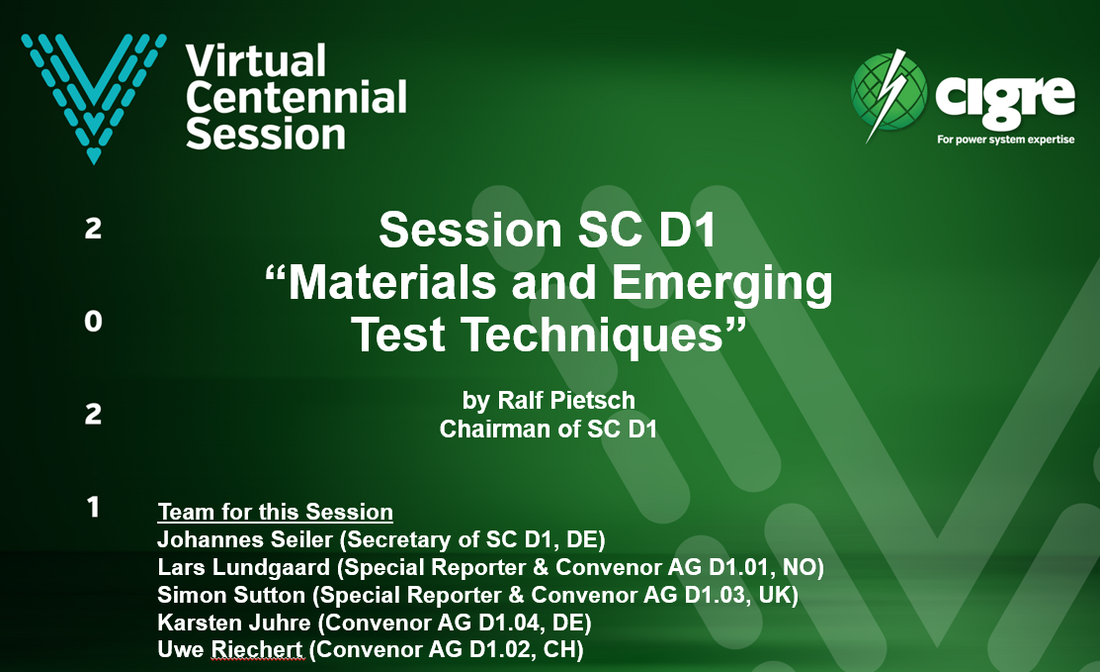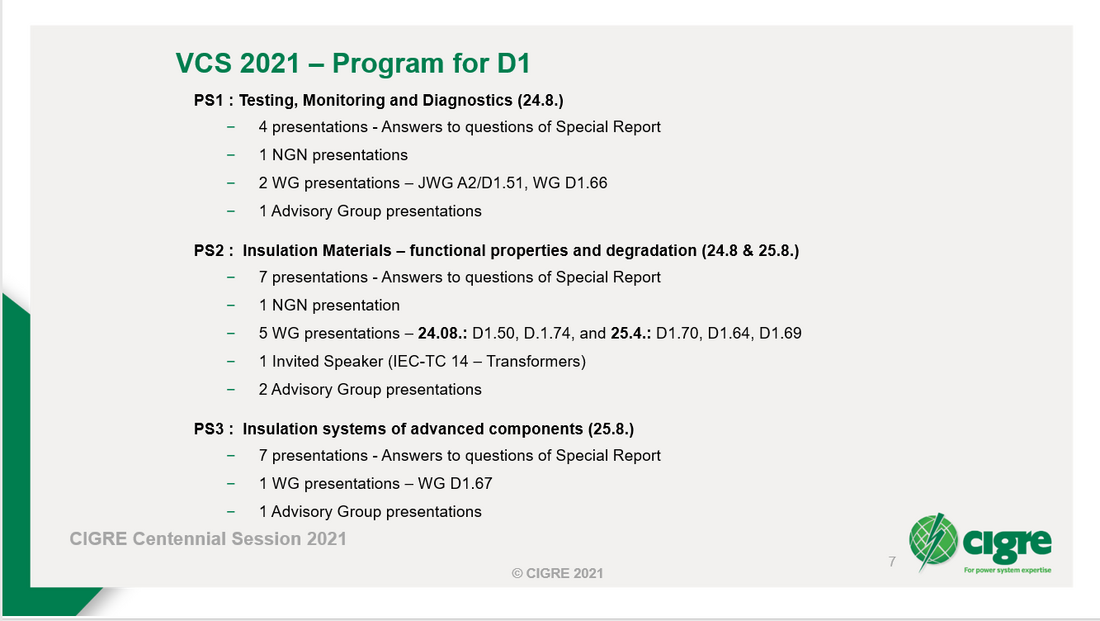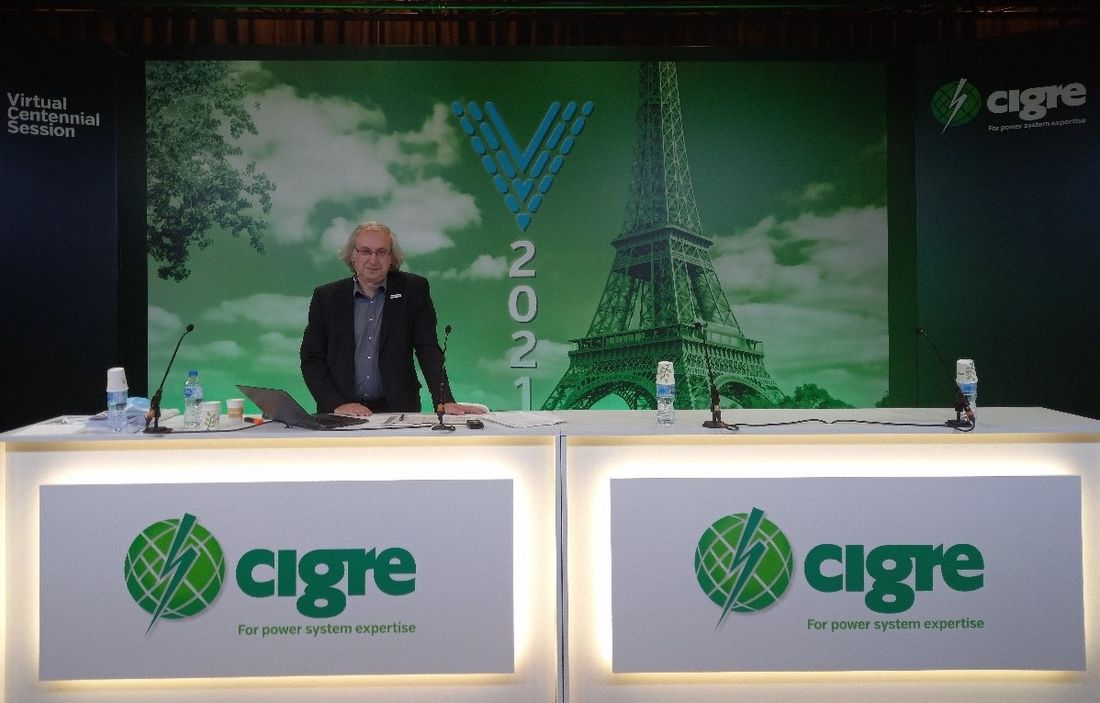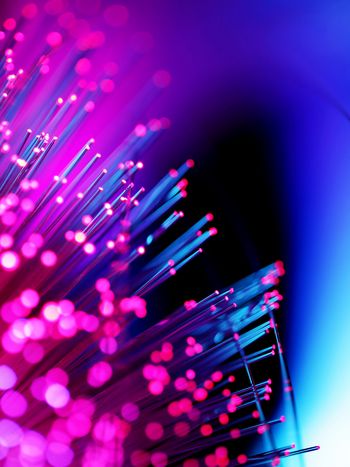Materials and emerging test techniques
By Ralf Pietsch, Chair & Johannes Seiler, Secretary
Scope, Organisation and Membership
As a common practise, we like to present our Annual Report of 2021. Our scope of Study Committee D1 has not changed within the last years. It covers new and existing materials for electrotechnology, diagnostic techniques and related knowledge rules, and emerging test techniques which may be expected to have a significant impact on power systems in the medium to long term. As a horizontal Study Committee, SC D1 strives to support the other CIGRE Study Committees and external customers as well. The mission of SC D1 is to facilitate and promote the progress of engineering and the international exchange of information and knowledge. It achieves this through the synthesis of state-of-the-art practices and developing recommendations, as well as identifying, investigating, and monitoring the use of new or novel materials, test techniques and generic concepts for diagnosis.
Test and measurement procedures are developed using knowledge of the performance of materials and electrical insulating systems (EIS) about electrical, thermal, mechanical, chemical, and environmental stresses. These can then be applied to the development of new diagnostic and analytical methods for asset management of electrical apparatus to aid the work of equipment, subsystem, and system committees.
The current membership of the SC consists of 23 regular members, 6 additional regular members and 12 observer members. One new WG has been approved by the TC chairman in 2021 and 4 WGs will be disbanded, thus SC D1 counts presently 21 WGs, including 2 Joint WGs with SC B1, one JWG with B1 and B3 and 2 JWG with SC A2. In total, about 430 expert members from 39 countries are active in SC D1 working bodies. In addition, one new Advisory Group (Gases), started, dealing with gases and mixtures. All activities can be grouped in four areas, namely “Insulating gases”, “Liquid and liquid impregnated insulation systems”, “Solid materials” and “High voltage and high current testing and diagnosis”. The major activities in the various areas covered by D1 WGs are shown in Figure 1 and details are given below.
Materials
SC D1 deals with materials for electrotechnology which covers a wide variety of conducting and insulating materials including novel materials such as superconductors and nanocomposites. Many materials considered are insulating materials and the focus is on material characteristics and performances.
In practical applications, insulating materials are used in structures containing one or more electrical insulating materials together with associated conducting parts employed in an electrical device, thus forming an electrical insulating system (EIS). The life of an EIS is frequently determined by the life of electrical equipment under electrical, thermal, mechanical, and environmental stresses, acting either individually or in combination (IEC 60505). SC D1 deals with the associated ageing processes which affect materials, which are used in generation, transmission, and distribution of electric energy, and not only covers the materials but also interfacial phenomena.
Liquid and liquid impregnated insulation systems, organized by AG D1.01 (L. Lundgaard)
The work focussed on basic phenomena and mechanisms of conductivity, dielectric performance, dielectric strength and ageing of relevant materials and insulating systems, covering traditional insulating fluids as well as biodegradable fluids. The work aims to discover and understand the basic physical and chemical mechanisms associated with ageing, thus forming the basis for diagnostics and asset management of products like transformers and liquid impregnated cables. As example JWG A2/D1.51 strives to develop improvements to partial discharge measurements for factory and site acceptance tests of power transformers by measuring high electromagnetic waves with the ultra-high frequency (UHF) method. The results will be published in a TB at the end of 2021. WG D1.68 is dealing with natural synthetic esters – evaluation of the performance under fire and the impact on environment and WG D1.70 is studying functional properties of modern insulating liquids for transformers and similar electrical equipment; The results of TF 3 of this WG D1.70 will be published until end of 2021. One new WG was established this year. WG D1.76 with the title “Test for verification of quality and ageing performance of cellulose insulation for power transformers” is dealing with DP measurement and the relations between functional mechanical properties of cellulose products and measured DP-values. Acceleration factors will also be investigated and possibilities to introduce alternative algorithms for modelling cellulose ageing to improve transformer life assessment.
High voltage and high current testing and diagnosis, organized by AG D1.02 (U. Riechert)
In general, methods of testing and related techniques of measurement can be very different depending on the test object, the purpose of testing and on the conditions of testing. For example, the object of the test can be the materials, insulating systems, equipment, subsystems, and systems; the purpose of testing can be to determine characteristic properties of the test object, such as electrical, thermal, mechanical, and chemical properties as well as ageing performance under various stresses. Further, the purpose can be for design, type, sample, or a routine test of the equipment. The test can also be performed on-site or off-site as well as under on-line or off-line conditions. Testing always goes along with the requirement to measure the stresses as well as the response of the device under test to analyse the test results and to evaluate the performance of the test object. Lastly, testing can be used to collect information which form a basis for diagnosis, e.g., to evaluate the condition of a test object.
The development of test techniques is driven by various factors, like the introduction of new materials or electrical insulating systems (e.g., polymeric materials, nanocomposites), new requirements on accuracy (e.g., more precise correction factors) or on higher stress levels (i.e., UHVAC, UHVDC) or new test objects (e.g., testing of artificially or naturally polluted insulators). SC D1 studies and synthesises state-of-the-art techniques of testing and measurement, develops relevant recommendations and new diagnostic and analysis methods for asset management, all in close cooperation with its customers.
According to a request from IEC TC 42 the WG D1.50 has been established, dealing with atmospheric and altitude correction factors for air gaps and clean insulators. After having checked and evaluated the existing correction factors for installations up to 6.000 m above sea level round robin tests will be performed by the members of the WG. Finally, guidance shall be given on modifications of the atmospheric and altitude correction factors. WG D1.54 studies basic principles and practical methods to measure the AC and DC resistance of conductors of power cables and overhead lines. The aim is to define a test procedure including suitable equipment for the measurement of AC and DC resistance considering the major factors of influence, e.g., frequency of current, current density and conductor temperature. WG D1.60 has been established to coordinate the development of suitable hardware and software for traceable measurement techniques for very fast transients, e.g., very fast transient overvoltage (VFTO), in order widen the basis for reference measurement capabilities meeting the relevant calibration requirements. WG D1.61 accepted the challenge to develop objective methods and indicators which can be used for optical corona measurements on overhead lines and equipment, preferably by performing comparative measurements on different sites and laboratories and by application of different types of cameras.
To support the development of existing IEC standards, WG D1.63 studies methods of partial discharge detection under DC stress and the analysis of partial discharge activity with respect to pulse patterns and the sequence of pulses under various factors of influence, e.g., slope of voltage change, voltage magnitude, and material properties of the test object. The response of measuring instruments and possibilities of noise suppression will be addressed. WG D1.69 is dealing with guidelines for test techniques of High Temperature Superconducting (HTS) systems. WG D1.72 is dealing with test of material resistance against surface arcing under DC and WG D1.74 is investigating PD measurement on insulation systems stressed from HV power electronics. The JWG B1/B3/D1.79 is caring about recommendations for dielectric testing of HVDC gas insulated system cable sealing ends.
As a resume, one can observe that the focus of our working group activities has changed within the last 11 year. We observe a quite strong increase of topics dealing with DC. This includes discussion and defining how to test DC-GIS, investigation of PD activities under DC, surface arcing under DC, methods to measure the AC and DC resistance of conductors of cables & overhead lines and the evaluation of dynamic hydrophobicity of polymeric insulating materials under AC and DC voltage stress. Furthermore, the focus within SC D1 shifts to testing & diagnostics.
Solid materials, organized by AG D1.03 (S. Sutton)
In the field of solid materials, the current focus is on polymeric insulating materials. In view of the lack of a standardised test to evaluate the residual content of methane and other flammable gases evolved as by-products during the crosslinking process of XLPE insulation, JWG D1/B1.49 has developed a harmonised test procedure for the measurement of residual flammable gases in insulating materials, published in October 2021 in TB 850. WG D1.58 studies suitable test procedures for the evaluation of dynamic hydrophobicity of polymeric insulating materials under AC and DC voltage stress. WG D1.59 studied methods for dielectric characterisation of polymeric insulating materials for outdoor application with the aim to elaborate guidelines for performing precise and repeatable measurements of dielectric properties. Results are published in TB 822 in December 2020. The experts of WG D1.62 are dedicated to exploring the root cause and mechanisms of surface degradation in polymeric materials for outdoor use, and to derive potential countermeasures for various material groups. WG D1.64 was established to explore electrical insulation systems at cryogenic temperatures. This WG published its results in October 2021 as TB 846. WG D1.73 is dealing with the multi-functionality of nanostructured dielectrics and JWG D1/B1.75 with strategies and tools for corrosion prevention for cable systems.
Insulating gases, organized by AG D1.04 (K. Juhre)
Based on the phenomena in electrical gas-insulated systems under DC and transient voltage stress and considering the properties of the involved materials JWG D1/B3.57 investigated appropriate testing strategies for gas-insulated HVDC systems. Their results are published as TB 842 in September 2021. WG D1.66 is dealing with requirements for partial discharge monitoring systems for gas insulating systems. WG D1.67 focused on the dielectric performance of non-SF6 gases and gas mixtures for gas-insulated systems and published their results in October in TB 849. Additional information is given in WG Report WGR_319_1.

CIGRE active Working Groups / Call for experts
Relations to other organisations
SC D1 strives to establish and maintain good relations to internal customers, i.e., equipment and sub-system committees, as well as to external organizations, like IEC, IEEE and CIRED. The main partners within IEC are TC 2 “Rotating Machines”, TC 10 “Fluids for Electrotechnical Applications”, TC 14 “Power Transformers”, TC 36 “Insulators”, TC 42 “High-voltage and high-current test techniques”, TC 90 “Superconductivity”, TC 99 “Insulation co-ordination and system engineering” and TC 112 “Evaluation and Qualification of Electrical Insulating Materials and Systems “. SC D1 also has a good relationship with the relevant IEEE organisations. With some technical committees of these organisations, SC D1 has established formal liaisons.
Tutorials and Future Connections
SC D1 has established a good set of tutorials covering specific topics in its field of activity. A list of tutorials (27 at present) is available on CIGRE KMS system. This year the following tutorials were held:
- “Dielectric Testing of gas-insulated HVDC Systems”, JWG D1/B3.57 - C. Neumann, Virtual Centennial Session, 23rd August 2021
- “Moisture Measurement in Insulating Fluids and Transformer Insulation – an Evaluation of Solid-State Sensors and Chemical Methods”, WG D1.52 - Tim Gradnik, 41. CIGRE Symposium 2021, Ljubljana, 21.09.2021
Publications
The following CIGRE Technical Brochures are published in 2021:
Additionally, WG D1.67 published a Working Group Report, WGR_319_1, with further results, “Design criteria for experiments to measure the breakdown voltage of insulating gases in uniform electric fields”, October 2021.
It is planned to finalize and publish the results of two additional WGs until end of 2021:
JWG A2/D1.51 with Sebastian Coenen (DE) as Convenor and WG D1.70 TF3, with Lars Lundgaard (NO) as Task Force Leader.
Christian Franck, convener of WG D1.67 wrote a short contribution for the newsletter “Future Connections” with the title “Electric performance of new non-SF6 gases and gas mixtures for gas-insulated systems”.

Awards
This year the CIGRE Technical Council Award was granted to Stefan Kornhuber (DE) for his expertise and outstanding contribution to the CIGRE community.
To organize and support the CIGRE Session 2020 and 2021 under the challenging conditions in 2020 and 2021 the special “CIGRE Pioneer 2020 e-session Achievement Award” was given to Lars Lundgaard, Simon Sutton, and Ralf Pietsch to recognise their outstanding efforts of SC D1 to the achievement of the 2020 e-session and of the VSC Session.
Meetings and events
This year SC D1 participated at the Virtual Centennial Session, VCS 2021, with our Group Discussion Meeting on 24 August (116 unique attendees) and 25 August (111 unique attendees) together with the tutorial of JWG D1/B3.57 (130 unique attendees).
The Chairman and the Secretary of SC D1 like to express their sincere thanks to all authors for their contributions and presentations.


Without the strong support, coordination, and good preparation by Johannes Seiler (DE, Secretary), the Special Reporters Lars Lundgaard (NE) and Simon Sutton (GB), this fruitful GDM meeting would not be possible.
Furthermore, the chairman also like to thank all Advisory Group convenors, Lars Lundgaard (NO), Uwe Riechert (CH), Simon Sutton (GB) and Karsten Juhre (DE). They gave a short overview about their group and tasks and acted as moderators together with Johannes Seiler who runs the Q&A during this session.
As a team, we successfully realized an interesting and well-organized Group Discussion Meeting at this very special Centennial Virtual Session.
Finally, as this will be the last Annual Report under my chairmanship, I like to express my deep thanks to my secretary, Johannes Seiler, and to all members, AG and WG convenors, and supporters of SC D1 for their expertise, contributions, work, very fruitful discussions, and ideas!

Hope to see you, at least some of you at the Session 49 in August 2022, and at our next Group Discussion Meeting, which is planned as a physical meeting in Paris too.
Dr. R. Pietsch, 10.11.2021
